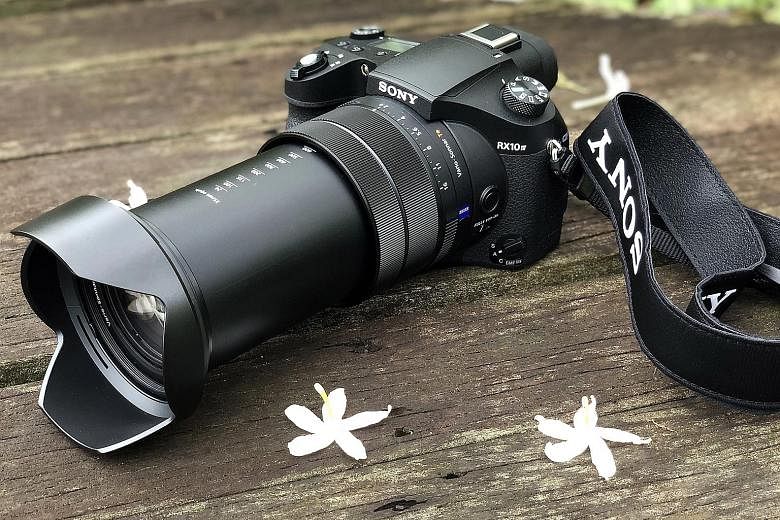The Sony Cyber-shot DSC-RX10 IV is an ultra-zoom compact camera. Cameras like it are sometimes referred to as bridge cameras, as they bridge the gap between compact and DSLR cameras.
Most bridge cameras come with long optical zoom lenses that can start at 28mm and go to 500mm. But they have small apertures that go no larger than f/6.5 or f/8, at the maximum focal length.
Not the RX10 IV. It has a non-interchangeable lens with a focal length of 24mm to 600mm, but still manages to have a large aperture of f/4 at 600mm. Furthermore, at its shortest focal length, its widest aperture is f/2.4, a stop or two more than its competitors.
This makes the RX10 IV ideal for shooting wildlife, and a great vacation camera that lets you go quickly from capturing wide landscape shots in a safari park to zooming in on that zebra in the distance.
The RX10 IV has 315 phase-detection autofocusing (AF) points, compared with the mere 25 contrast-detection AF points of the Mark III version. Shooting speed is 24 frames per second (fps), up from its predecessor's 14fps. it has a touchscreen display, with a resolution of 1.44 million dots.
Design-wise though, the RX10 IV does not differ much from its predecessor. There is a mode dial on the top left, and an exposure compensation dial on the top right. You can change the aperture size quickly using the aperture barrel ring, and adjust the shutter speed using the rear dial in manual mode. Focal length is easily adjusted by using the zoom lever around the shutter release, or by turning the step zoom barrel of the lens.
The contoured rubberised grip provides a great grasp of the camera. Overall handling feels like that of a DSLR camera.
-
TECH SPECS
-
PRICE: $2,499
IMAGE SENSOR: 20.1-megapixel 1-inch CMOS
LENS: 24mm-600mm f/2.4-f/4
DISPLAY: Tiltable 3-inch LCD with 1.44 million dots; built-in electronic viewfinder with 2.36 million dots
SENSITIVITY: ISO 64-12,800
SHOOTING SPEED: Up to 24 frames per second
CONNECTIVITY: Wi-Fi, Bluetooth, Near Field Communications
WEIGHT: 1,095g (with battery and memory card)
-
RATING
FEATURES: 5/5
DESIGN: 4/5
PERFORMANCE: 4/5
BATTERY LIFE: 4/5
VALUE FOR MONEY: 3/5
OVERALL: 4/5
The camera starts up in 1.6sec and shuts down in around 2sec - comparable to most compact cameras but fast for a bridge camera.
Using an SD card with a writing speed rated at 95MB per second, the RX10 IV was able to shoot 112 RAW still images in 4.9sec before the buffer ran out. This is amazing shooting speed that puts many DSLR cameras to shame.
AF is almost instantaneous in bright sunlight, when at the shorter end of the focal range.
From 300mm onwards, getting a focus lock with AF can take up to 1sec, especially for scenes without much contrast. But when the AF area is set to wide, and shooting drive mode to high-speed continuous, I was able to capture fast-flying pigeons sharply.
In dim lighting conditions and between focal lengths of 24mm and 200mm, it takes at most 1sec to get a focus lock with the aid of the AF assist light. From 300mm onwards, it can take up to 3sec to secure a focus.
Images exhibit sharp details, with low barrel distortion throughout its long focal range. But images shot from 500mm and 600mm at f/4 look a tad soft. There were no visible noise artefacts at ISO 800. Even at ISO 1,600, where I could see noise, there was no significant loss of details. Pictures shot at ISO 3,200 are still good enough for small prints or Web use. But anything above ISO 6,400 is not recommended due to significant loss of details and chromatic noise.
Battery life takes a slight hit, dropping to around 400 still image shots on a full charge compared with its predecessor's 420 shots.
One issue is the price. The RX10 IV is priced $200 more than its predecessor. Furthermore, at its price of $2,499, you can get a mid-range APS-C DSLR camera.
However, you will need to spend tens of thousands of dollars if you want a camera that can go as wide as f/4 at 600mm. For example, the Canon EF600mm f/4 lens will set you back $18,159.
• Verdict: The Sony Cyber-shot RX10 IV is probably the most versatile bridge camera you can get in the market - that is, if you are willing to pay.


